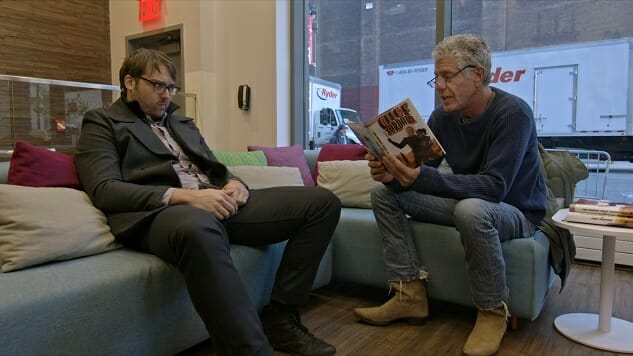Jonah Ray Hones His Bourdain Parody on the Second Season of Hidden America

When Jonah Ray’s Hidden America debuted last summer on Seeso, it brought the pitch-perfect specificity the platform aspires to in spades. Ray, playing himself as an egocentric travel show host, traveled from American city to American city in search of experiences authentic to that city, portraying with laser accuracy the TV-friendly punk tourism of Anthony Bourdain (complete with lofty subtitles like “Los Angeles: All That Glitters is Not Gold” and “Chicago: The Second Best City”). This sits well with Ray, who wanted to do a show like Monty Python or Mr. Show, where one sketch flows into the next, but that was also a visually specific parody. “Me and my friend Peter Atencio [Key and Peele, Keanu] would always have these conversations about how sketch doesn’t just have to service the comedy, it could also look really good,” says Ray. “[This] was kind of a way to pull in all my interests.”
But in terms of Hidden America’s second season, which premieres May 5 on Seeso, the accuracy of season one was not necessarily incompatible with a heightened comedic approach. “There’s a thing that happens in parody where you get lost in it, and you’re just making the thing you thought you were making fun of,” says Ray. “I allowed the show to get a little sillier, not do so much bait-and-switch, and just kinda have a bit more fun…”
The blend of parodic specificity and absurdity has become something of a calling card for Seeso (for reference, Bajillion Dollar Propertie$ or HarmonQuest), which found its way to Hidden America circuitously. The initial network passed because they thought it was going to be a “funny travel show, not a fake travel show…” says Ray. “I only want to be involved in fake things.” This itself speaks to Hidden America’s anarchic spirit, which is only bolstered by season two’s angle. “I thought ‘this time it’s going to be a little less crazy,’” says Ray. “But we’re on a shoestring budget, there’s only a few of us, it’s a lot to get done in a short amount of time, and it’s sketch, where it’s always good to have a little time to play.”
Season two also pushes the show’s format forward in its approach towards the cities it mocks, a practice that has always been based off a mix of prior experience and cultural reputation. You know, like how Cleveland’s reputation has always been that it just sucks. However, a new episode of Hidden America acknowledges that, like Detroit, Cleveland is going through an artist and artisan-fueled revitalization, and uses that disparity as its operating premise. One memorable character is so sensitive about Cleveland’s reputation that he disparages all of its actually-pretty-cool features before anyone can get their hopes up too high. Likewise, Reno, Nevada is one of the saddest cities on the planet. “Its spirit animal is a deadbeat dad from the ‘70s,” says Ray. “To subvert that, we make it as flashy and awesome as we possibly can.” Additionally, Minneapolis became an opportunity to fill an episode with Mystery Science Theater 3000 cameos, a choice that is all the more satisfying now that Ray is doing double-duty hosting that show’s Netflix revival as well.
But the most notable comic break from reality this season may be the presence of the man who inspired it in the first place. Bourdain had seen the show at one point, but the possibility of a guest appearance hadn’t come up until it was mentioned during Bourdain’s interview with Katherine Spiers of the L.A. Weekly, an old roommate of Ray’s. “She did the work for me,” he admits. Bourdain agreed, under the condition that he could play an outsized, buffoonish version of himself in the Larry Sanders tradition. “The tricky part is I’m already playing a more buffoonish and pretentious version of him,” says Ray. “So it was tricky to figure that out, but he was totally game.”
-

-

-

-

-

-

-

-

-

-

-

-

-

-

-

-

-

-

-

-

-

-

-

-

-

-

-

-

-

-

-

-

-

-

-

-

-

-

-

-








































